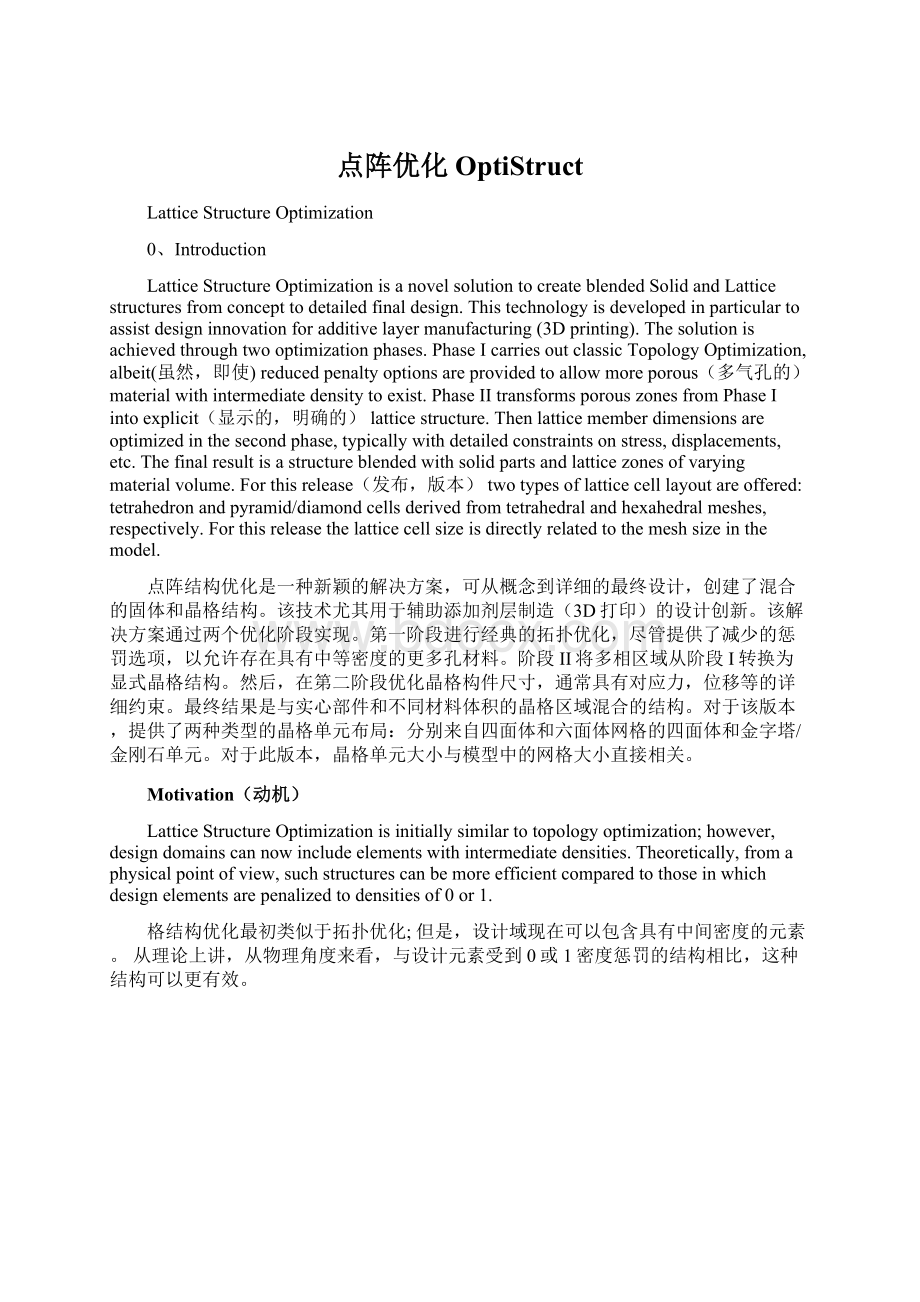点阵优化OptiStruct.docx
《点阵优化OptiStruct.docx》由会员分享,可在线阅读,更多相关《点阵优化OptiStruct.docx(38页珍藏版)》请在冰豆网上搜索。

点阵优化OptiStruct
LatticeStructureOptimization
0、Introduction
LatticeStructureOptimizationisanovelsolutiontocreateblendedSolidandLatticestructuresfromconcepttodetailedfinaldesign.Thistechnologyisdevelopedinparticulartoassistdesigninnovationforadditivelayermanufacturing(3Dprinting).Thesolutionisachievedthroughtwooptimizationphases.PhaseIcarriesoutclassicTopologyOptimization,albeit(虽然,即使)reducedpenaltyoptionsareprovidedtoallowmoreporous(多气孔的)materialwithintermediatedensitytoexist.PhaseIItransformsporouszonesfromPhaseIintoexplicit(显示的,明确的)latticestructure.Thenlatticememberdimensionsareoptimizedinthesecondphase,typicallywithdetailedconstraintsonstress,displacements,etc.Thefinalresultisastructureblendedwithsolidpartsandlatticezonesofvaryingmaterialvolume.Forthisrelease(发布,版本)twotypesoflatticecelllayoutareoffered:
tetrahedronandpyramid/diamondcellsderivedfromtetrahedralandhexahedralmeshes,respectively.Forthisreleasethelatticecellsizeisdirectlyrelatedtothemeshsizeinthemodel.
点阵结构优化是一种新颖的解决方案,可从概念到详细的最终设计,创建了混合的固体和晶格结构。
该技术尤其用于辅助添加剂层制造(3D打印)的设计创新。
该解决方案通过两个优化阶段实现。
第一阶段进行经典的拓扑优化,尽管提供了减少的惩罚选项,以允许存在具有中等密度的更多孔材料。
阶段II将多相区域从阶段I转换为显式晶格结构。
然后,在第二阶段优化晶格构件尺寸,通常具有对应力,位移等的详细约束。
最终结果是与实心部件和不同材料体积的晶格区域混合的结构。
对于该版本,提供了两种类型的晶格单元布局:
分别来自四面体和六面体网格的四面体和金字塔/金刚石单元。
对于此版本,晶格单元大小与模型中的网格大小直接相关。
Motivation(动机)
LatticeStructureOptimizationisinitiallysimilartotopologyoptimization;however,designdomainscannowincludeelementswithintermediatedensities.Theoretically,fromaphysicalpointofview,suchstructurescanbemoreefficientcomparedtothoseinwhichdesignelementsarepenalizedtodensitiesof0or1.
格结构优化最初类似于拓扑优化;但是,设计域现在可以包含具有中间密度的元素。
从理论上讲,从物理角度来看,与设计元素受到0或1密度惩罚的结构相比,这种结构可以更有效。
Figure1:
DifferencebetweenLatticeOptimization(Phase1)andTopologyOptimization.
ApossiblemajorapplicationofLatticeStructureOptimizationisAdditiveLayerManufacturingwhichcantakeadvantageoftheintricate(复杂的)latticerepresentationoftheintermediatedensities.Thiscanleadtomoreefficientstructuresascomparedtoblockystructures,whichrequiremorematerialtosustainsimilarloading.
点阵结构优化的一个主要应用是增材制造,其可以利用中间密度的复杂晶格表示。
与块状结构相比,这可以导致更有效的结构,块状结构需要更多的材料来维持类似的负载。
Itshouldbenotedthattypicallyporousmaterialrepresentedbyperiodiclatticestructuresexhibitslowerstiffnesspervolumeunitcomparedtofullydensematerial.Fortetrahedronanddiamondlatticecells,thehomogenizedYoung'smodulustodensityrelationshipisapproximatelygivenas
whereE0specifiesYoung'smodulusofthedensematerial.
应当注意,与完全致密的材料相比,通常由周期性晶格结构表示的多孔材料表现出每单位体积更低的刚度。
对于四面体和金刚石晶格单元,均匀化的杨氏模量与密度的关系近似给出,其中E0指定致密材料的杨氏模量。
Varyinglevelsoflattice/porousdomainsintopologyresultsarecontrolledbytheparameterPOROSITY.WithPOROSITYdefinedasLOW,thenaturalpenaltyof1.8isapplied,whichwouldtypicallyleadtoafinaldesignwithmostlyfullydensematerialsdistribution(orvoids)ifasimple'stiffeststructure'formulation(complianceminimizationforagiventargetvolume)isapplied.
拓扑结果中不同层次的格子/多孔域是由参数孔隙度控制的。
由于孔隙度被定义为低,应用了1.8的自然惩罚,这通常会导致最终的设计,如果一个简单的“最硬结构”的公式(给定目标量的遵从最小化)被应用,那么它的最终设计将会是完全密集的材料分布(或空洞)。
拓扑结果中晶格/多孔域的不同水平由参数POROSITY控制。
将POROSITY定义为LOW,应用1.8的自然罚分,如果采用简单的“最硬结构”公式(对于给定目标体积的顺应性最小化),通常会导致最终设计具有大部分完全致密的材料分布(或空隙)。
应用。
However,youmayfavor(喜欢)higherproportion(比例)oflatticezonesinthedesignforconsiderationsotherthanstiffness.Thesecanincludeconsiderationsforbucklingbehavior,thermalperformance,dynamiccharacteristics,andsoon.Also,forapplicationssuchasbiomedical(生物医学的)implantsporosityofthecomponentcanbeanimportantfunctionalrequirement.Forsuchrequirements,therearetwodifferentoptionsforPOROSITY.AtHIGH,nopenaltyisappliedtoYoung'smodulustodensityrelationship,typicallyresultinginahighportionoflatticezonesinthefinalresultsofPhaseI.AtMED,areducedpenaltyof1.25isappliedforamediumlevelofpreferenceforlatticepresence.
POROSITY为LOW时,惩罚因子为1.8。
点阵结构的比例最低;
POROSITY为MED时,惩罚因子为1.25。
点阵结构的比例中间;
POROSITY为HIGH时,惩罚因子为1,即无惩罚。
点阵结构的比例最高;
但是,除了刚度之外,您可能更倾向于在设计中使用更高比例的晶格区域。
这些可包括对屈曲行为,热性能,动态特性等的考虑。
而且,对于诸如生物医学植入物的应用,部件的孔隙率可以是重要的功能要求。
对于这些要求,POROSITY有两种不同的选择。
在HIGH时,杨氏模量与密度关系没有受到任何惩罚,通常在第一阶段的最终结果中导致晶格区域的高比例。
在MED,对于晶格存在的中等优先级,应用减少的1.25的惩罚。
DesignconstraintscanbedefinedinbothPhaseIandIIoftheLatticeOptimizationprocess.Somespecificconstraints,likestresses(viaLATSTR)arenotappliedtothefirstphase,butpassedtothesecondphase.AlthoughsomedesignconstraintsareappliedduringPhaseI,itisimportanttoconsidereveryrequireddesignconstraintduringPhaseIIoftheoptimizationprocess.
可以在点阵优化过程的第一阶段和第二阶段中定义设计约束。
一些特定的约束,如应力(通过LATSTR)不适用于第一阶段,而是传递到第二阶段。
尽管在阶段I期间应用了一些设计约束,但在优化过程的阶段II期间考虑每个所需的设计约束是很重要的。
ThedesignconstraintsdefinedinPhaseIIshouldbesufficientlyexhaustivetosustaintheusecaseifthefinaldesignisexpectedtobe‘3Dprinted’directly.Fortraditionalstructures,usersusuallygothroughasecondstagewherethetopologyconceptisinterpretedandthenfine-tunedbysizeoptimizationwithalldesignconstraintsincluded.Thesecondphaseofthelatticeoptimizationprocessshouldbeviewedasthefine-tuningstageforthedesignsincefurthermanualmanipulationofalatticestructurewithhundredsofthousandscellmembersisclosetoimpossible.
如果期望最终设计直接“3D打印”,则阶段II中定义的设计约束应足够详尽以维持用例。
对于传统结构,用户通常会经历第二阶段,其中解释拓扑概念,然后通过包括所有设计约束的尺寸优化进行微调。
点阵优化过程的第二阶段应该被视为设计的微调阶段,因为进一步手动操纵具有数十万个单元成员的晶格结构几乎是不可能的。
重要的思考:
在设计结构之前,该结构是用3D打印,还是用传统的加工制造方法生产。
若是3D打印:
在拓扑时应该尽可能的考虑到所有的失效等约束,但是考虑生产加工的约束可以少点,因为一般度都能打印出来。
一般不需要进一步进行详细的尺寸等优化了。
传统的加工制造方法生产:
则拓扑优化只是一个参考,看看力怎么传递,效率更高,还需要进行对拓扑优化的结果进行解释,对结果进行结构的重构,再进行尺寸等的进一步详细优化设计。
1、LatticeGeneration(Phase1)
Inthefirstphase,thedesigndomainsareoptimizedsimilartoaregulartopologyoptimization,exceptthatintermediatedensityelementsareretainedinthemodel.Asexplainedabove,thistheoreticallymayimproveperformanceoftheoptimizedstructureforconsiderationsotherthancompliance(forexample,buckling)whencomparedtoaregulartopologyoptimization.Theintermediatedensitiesintheoptimizedstructurearerepresentedbyuser-definedlatticetypes(micro-structures)点阵类型.Thevolumefractionofthelatticestructurecorrespondstotheelementdensityattheendofthefirstphase.Duringtheoptimizationprocess,stiffnessoftheintermediatedensitiescorrespondstomicro-structuralhomogenizedproperties.
在第一阶段,设计域的优化与常规拓扑优化类似,只是中间密度元素保留在模型中。
如上所述,与常规拓扑优化相比,这在理论上可以提高优化结构的性能,以用于除了柔度(例如,屈曲)之外的考虑。
优化结构中的中间密度由用户定义的晶格类型(微结构)表示。
晶格结构的体积分数对应于第一阶段结束时的元素密度。
在优化过程中,中间密度的刚度对应于微结构均匀化性质。
Definition
ThefirstphaseoftheLatticeoptimizationprocessrequirestheinclusion(包括、包含)oftheLATTICE(晶格)continuationline(延续行)onallDTPLbulkdataentries.
重点:
在帮助文档中,查DTPLbulkdataentries,还有LATTICE
ThisactivatesLatticeoptimization,andtheLBandUBfieldscanbeusedtospecifytherangeofdensitiesforelementsthatcanbeconvertedintoLatticeelements.ElementswithdensitiesaboveUBremainassolidelementsandthosewithdensitieslowerthanLBareremovedfromthemodel.
DTPL–DesignVariableforTopologyOptimization
晶格优化过程的第一阶段要求在所有DTPL批量数据条目上包含晶格延续线。
这将激活晶格优化,并且可以使用LB和UB字段来指定可以转换为晶格元素的元素的密度范围。
密度高于乌兰巴托的元素仍然是固体元素,而密度低于LB的元素则从模型中移除。
ThesolidelementswhichliewithintheLBandUBdensitybounds(intermediatedensities)definedontheLATTICEcontinuationlinearereplacedbythecorrespondingLatticeStructures(LatticeType–LT).Thesolidelementscanbefirstorsecondorderelements.Thelatticestructuresareconstructedusing1DTaperedBeam(CBEAM)elements,asshownbelow.Theinitialradiusofthelatticestructurebeamelementsforeachlatticestructurecellisproportionalto(成比例)thedensityoftheintermediatedensityelementswhichwerereplaced,suchthattheinitialvolumeinphase2isequaltothatattheendofphase1.
位于LATTICE延续线上定义的LB和UB密度范围(中间密度)内的实体元素由相应的格子结构(格子类型-LT)代替。
实体元素可以是一阶或二阶元素。
晶格结构使用1D锥形梁(CBEAM)元件构造,如下所示。
每个晶格结构单元的晶格结构梁元件的初始半径与被替换的中间密度元件的密度成比例,使得阶段2中的初始体积等于阶段1结束时的初始体积。
Inphase2,theconceptoflatticebeamelementradiusisinterpretedasjointthickness.Thicknessforeachjointattheconjunctionoflatticebeamelements(在晶格梁的结合处,每个关节的厚度)isdeterminedandtheradiusofeachelementcanvaryacrossthebeamlength.ThebeamelementshavethepropertyPBEAMLandTYPE=RODisautomaticallyassignedforeachelement.Thethicknessofthistaperedbeamelementcanvaryalongitslengthandonlycircularcross-sectionsareavailable.TheX
(1)/XBfieldonthePBEAMLentryisalwayssetto1.0fortaperedbeamelements.
jointthickness.?
在阶段2中,格子梁单元半径的概念被解释为接头厚度。
确定在格子梁元件的连接处的每个关节的厚度,并且每个元件的半径可以在梁长度上变化。
梁元素具有PBEAML属性,并且为每个元素自动分配TYPE=ROD。
该锥形梁元件的厚度可以沿其长度变化,并且仅可以获得圆形横截面。
对于锥形梁单元,PBEAML条目上的X
(1)/XB字段始终设置为1.0。
锥形梁单元:
线性变化的,只要确定两端的面积,就可以确定任意位置的面积
ForTYPE=ROD,ifX
(1)/XBisequalto1.0,theDIM
(1)AreferencestheradiusofthebeamatendAandDIM
(1)1referencestheradiusofthebeamatendB.Thiselementisataperedbeamformulation,andaveragingisnotusedtodeterminetheaverageradiusofthebeam.Instead,thetruetaperedbeamformulationisusedwiththegivendimensions.ThetruetaperedbeamformulationisonlyavailableforTYPE=ROD.
对于TYPE=ROD,如果X
(1)/XB等于1.0,则DIM
(1)A参考A端的梁半径,DIM
(1)1参考端B处梁的半径。
是锥形梁公式,平均值不用于确定梁单元对的平均半径。
相反,真正的锥形梁配方与给定的尺寸一起使用。
真正的锥形梁配方仅适用于TYPE=ROD。
TheLATSTRfieldontheLATTICEcontinuationlinecanbeusedtospecifythestressconstraintforthesecondphase(StressConstraints).
LATTICE延续卡片上的LATSTR字段可用于指定第二阶段的应力约束(应力约束)。
ThelatticetypecanbecontrolledusingtheLTfieldontheLATTICEcontinuationline.ThevaluesLT=1,2,3,or4canbeusedtocontroltheLattice